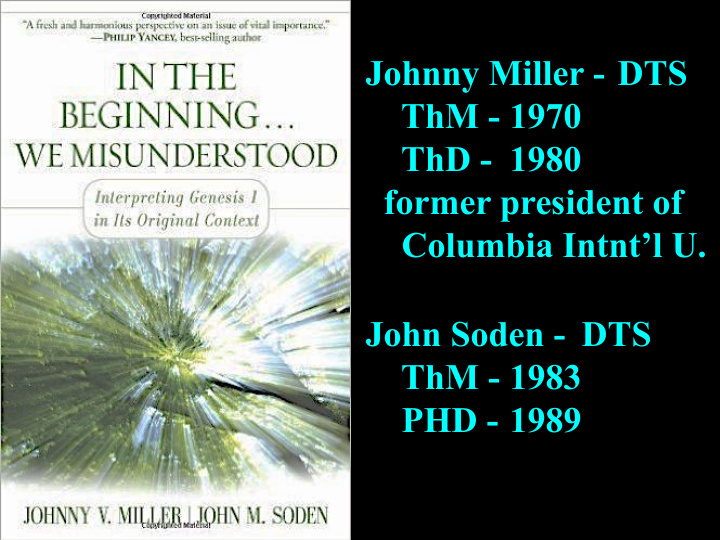



Johnny Miller - DTS ThM - 1970 ThD - 1980 former president of Columbia Intnt’l U. John Soden - DTS ThM - 1983 PHD - 1989
MILLER Background Ø Raised in fundamentalist, Bible teaching church Ø Inspiration & inerrancy Ø H Morris -> young earth Ø had doubts about age of earth Ø ~1997 changed thinking -> science Ø Goal - authorial intention
SODEN Background Ø Raised studying ICR books Ø Under graduate - physical sciences Ø Saw conflicts between Gen 1 & science Ø Science does not determine text meaning Ø Goal - what did God mean
CONTENT 1. “We’ve Been Here Before” 2. Interpreting Scripture - author intent* inspiration, inerrancy, context, eliminating personal assumptions, historical & cultural context 3. “Science does not have ultimate authority over Scripture” 4. Indications in text to not take literally 5. If Gen 1 & 2 literal contradictions
“… leads us to conclude that it is a broadly figurative presentation of literal truths; it is highly stylized and highly selective. It does not report history as a journalist might do.” p 48
CONTENT 6. Purpose - gives Israel’s identity history meant to be read theologically 7. Focus on theology of creation not mechanics of it 8. Gen 1 compared & distinguished from Egyptian, Mesopotamian, & Canaanite
“… God chose not to correct all of the incorrect perceptions of the world ... we see God does correct wrong theology, but his instruction does not depend upon accurate scientific observations & descriptions of the material world” p 147-148
“… God chose to connect with them on a level that they could understand. ... God corrected their spiritual worldview, not their physical picture of the world, by teaching them who Yahweh their God was.” p 151
CONTENT 6. Purpose - gives Israel’s identity history meant to be read theology 7. Focus on theology of creation not mechanics of it 8. Gen 1 compared & distinguished from Egyptian, Mesopotamian, & Canaanite 9. Narratives not always chronological 10. Days of Gen 1 not literal 11. “Toward a Creation Theology”
STRENGTHS 1. Defense of inspiration, inerrancy, sound hermeneutics 2. Repeated emphasis on author intent 3. Background and cultural study of Egyptian, Babylonian, & Canaanites 4. Attempt to accurately treat text 5. Honest with assumptions & views
WEAKNESSES 1. Establishes excellent hermeneutics but then violates hermeneutics 2. Warns on injecting 21 st century science on text, then inject their scientific assumptions 3. Do not clearly identify their view on age of universe
APPROACHES 1. Accommodating text by injecting science theory on Gen 1 - Hugh Ross
ACCO ACCOMMO MMODATIO ATION 1. Emphasize supporting details 2. Superimpose current theories 3. Reinterpret text 4. Ignore non-supporting details
Scripture Science Theory
APPROACHES 1. Accommodating text by injecting science theory on Gen 1 - Hugh Ross authority - science 2. Seeking flexibility of Gen 1 to harmonize with science - Miller & Soden authority - Scripture & science 3. Interpret Gen 1 using G-H-C then re-interpret science theory - authority - Scripture alone
Recommend
More recommend